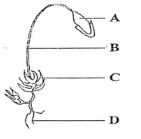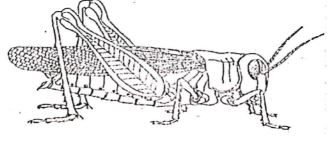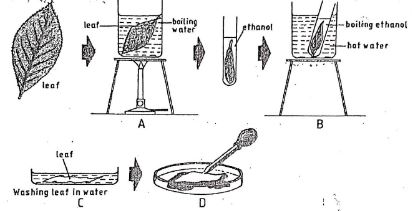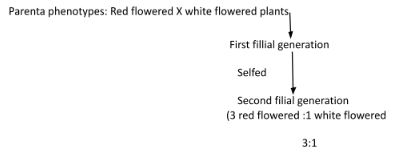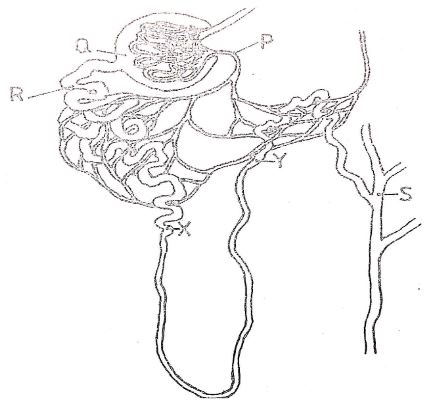BIOLOGY
PAPER 2

Questions
SECTION A
Answer all the questions in this section in the spaces provided.
-
- The diagram below represents a plant in the division Bryophyta.
- Name the parts labeled B and D. (2marks)
- State one function for each of the parts labeled A and C. (2marks)
- The diagram below represents a member of the kingdom Animalia.
- Name the phylum to which the organism belongs. (1mark)
- Using observable features in the diagram, give three reasons for the answer in b(i). (3marks)
- The diagram below represents a plant in the division Bryophyta.
- The set up below illustrates a procedure that was carried out in the laboratory with a leaf plucked from a green plant that had been growing in sunlight.
- What was the purpose of the above procedure. (1mark)
- Give reasons for carrying out steps A,B and C in this procedure. (3marks)
- Name the reagent that was used at the step labeled D. (1 mark)
- State the expected result on the leaf after adding the reagent named in (iii0 above. (1mark)
- The chart below represents the result of successive crosses, starting with red flowered plants and white flowered plants and in which both plants are pure breeding.
- What were parental genotypes? Use letter R to represent the gene for red colour and r for white colour. (2marks)
-
- What was the colour of the flowers in the first filial generation? (1mark)
- Give a reason for your answer in (b)(i) above. (2marks)
- 480 red flowered plants were obtained in the second filial generation, how many F2 plants were white coloured plants? Show your working. (3marks)
- The diagram below represents a mammalian nephrone.
- Name the:
- Structure labeled P. (1mark)
- Portion of the nephrone between point X and Y. (1mark)
- Name the process that takes place at point Q. (1mark)
- Name one substance present at point R but absent at point S in a healthy human. (1mark)
- The appearance of the substance you have named in (c above is a symptom of a certain disease caused by a hormone deficiency.
Name the :- Disease (1mark)
- Hormone (1mark)
- State the structure modifications of nephrones found in desert mammals. (2marks)
- State two advantages terrestrial animals have in excreting urea as their main nitrogenous waste product. (2marks)
- Name the:
- In an experiment on respiration ,a mouse was observed to have inhaled 200cm3 of oxygen and exhaled 199.75cm3 of carbon (IV)Oxide in ten minutes.
- Calculate the respiratory quotient for the activity in the experiment. (2marks)
- Identify the possible food substance consumed by the mouse.
- State the fate of the excess food named in (b)above in the human body. (2marks)
- Name the three end products of anaerobic respiration in plants.
SECTION B
Answer question 6 (compulsory) and either question 7 or 8 in the spaces provided after question 8
- A scientist carried out an investigation to find out the population growth of mice under laboratory conditions. Twenty young mice were placed in a cage. The results obtained from the investigation were as shown in the table below.
Time in months 0 2 4 6 7 10 12 16 18 Number of mice 20 20 65 115 310 455 450 145 160 - On the grid provided, draw a graph of the number of mice against time. (6marks)
- Account for the changes in mice population between.
- 0 to 2 months. (2marks)
- 2 to 6 months (2marks)
- 6 to 10 months (2marks)
- 10 to 12 months (2 marks)
-
- Between which two months was the population change greatest? (1mark)
- Calculate the rate of population change over the period in (c) (i) above. (2marks)
- What change in population was continued to the 19th month?
- To obtain the observed results state two variables that were kept constant during the investigation.

Marking Scheme
-
-
- B - Seta
D - Rhizoid - A - Contains spore bearing structures that bear spores
C - Contains chlorophyll for photosynthesis
- B - Seta
-
- Arthropoda
-
- Has jointed appendages
- Presence of exoskeleton
- Body is divided into head, thorax and abdomen hence segmented
- Has spiracles hence gaseous exchange is through trachea system
-
-
- Testing (a leaf) for the presence of starch
-
- Step A: Kill the leaf/cells/ protoplasm/stop enzymatic activity/ denature enzymes
- Step B: Removal of chlorophyll/ dissolve chlorophyll decolourise the leaf
- Step C: Soften leaf/ makes leaf less brittle
-
- Iodine solution
- Reject iodine alone
- Stain dark blue/ blue-black
-
- RR and rr
-
- Red
- Red is completely dominant over white colour i.e, Red is dominant while white is recessive
- Ratio of F2 generation = 3:1 (i.e in every 4 flowers 3 are red, 1 is white)
Therefore 480 red flowers means 3/4 of the total number i.e 3/4 = 480
Total numbers of flowers = 480 x 4 = 640
3
White flowers in F2 plants = 1/4 x 640 = 160
= 160 white flowered.
-
-
- Efferent arteriole
- Loop of henle
- Ultrafiltration
-
- Glucose
- Amino acids
-
- Diabetes mellitus
- Insulin
-
- Small Bowman's capsule/ glomerulus
- Long loop of henle
-
- Urea is less toxic and soluble in water thus easy to excrete
- Requires less water to eliminate hence prevents loss of water maintaining normal blood osmotic pressure.
-
-
-
- Respiratory quotient = volume of carbon (IV) oxide produced
volume of oxygen consumed
= 199.75cm3
200cm3
= 0.999
≈ 1.0
- Respiratory quotient = volume of carbon (IV) oxide produced
- Carbohydrates
-
- Excess glucose (a form of carbohydrate) is converted to glucogen fro storage in the liver and muscle cells
- Glucose is oxidised to releases energy
- Further excess carbohydrate in form of glucose is converted to fat for storage as a dispose tissue.
-
- Ethanol/ alcohol
- Energy/ Adenosine triphosphate
- Carbon (IV)oxide
-
-
-
-
- Population growth of mice is constant due to:
- The mice are still immature for reproduction
- Mice are still adjusting to their new environment
-
- Population growth of mice rose steadily/ had a slow growth due to
- Few number of mice have reached maturity
- Plenty of food for the mice
- Mice are already adjusted to their new environment.
-
- Rapid population growth due to
- There are many rats that were healthy thus able to reproduce, leading to massive growth in num bers
- The population was decreasing because of reduced resources as the number of rats became more
-
-
- 12 - 16
- Increase in population.
-
- Food & water( nutritional) supply
- Size of habitat.
Download Biology Paper 2 Questions and Answers - Form 4 Opener Term 1 Exams 2022.
Tap Here to Download for 50/-
Get on WhatsApp for 50/-
Why download?
- ✔ To read offline at any time.
- ✔ To Print at your convenience
- ✔ Share Easily with Friends / Students

